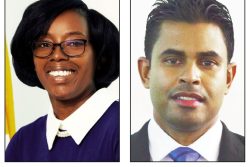Dear Editor,
In a news item in the KN captioned ‘PPP to use old model being to select presidential candidate’ dated September 23, 2010, extracted from a press release issued by the PPP General Secretary it was stated, “The process that was used in the selection of previous Presidents, Dr Cheddi Jagan, Mrs Janet Jagan and the current President Bharrat Jagdeo, will be used to select the People’s Progressive Party (PPP) Presidential Candidate for the next General Elections.”
It went on to say the procedure allowed for the expression of interest by interested individuals and “deliberations at the level of the Executive Committee, and subsequent approval by the Central Committee.”
I would like to suggest to the General Secretary that it was here the undermining of the constitution of the PPP commenced.
The Central Committee is stated in the party constitution to be the highest decision-making forum between congresses. What really takes place is discussions and decisions by the 15 member Ex-co and the rubber stamping of its decisions by the CC.
In addition there were attempts, which to some extent were successful, to stifle discussion within the CC as members of the executive took the position that those persons who had a minority view should not express them at the CC meeting. A few were brave enough to do so.
Such an insistence would have prevented CC members from benefiting from a more educated, broad-based view of the issues.
In addition there were pressures to prevent members of the CC from presenting differing views to guide members at special conferences called to discuss and decide upon specific issues.
They were supposed to go to these conferences and argue for the position taken by the majority.
In this way it boiled down to a possible 8 persons in the Ex-co having their way once they voted for a position.
Having said that , I would like to point out that the method was definitely not the same in the case of Dr Cheddi Jagan on the one hand and Janet Jagan and Jagdeo on the other. If anything Cheddi was an automatic choice. There were no other contenders, period.
In a letter by Ralph Ramkarran in the SN captioned ‘Mr Peters’ assertion that financial records were requested by the PPP and I refused to produce them is a complete fabrication’ (October 4), he says, “Mrs Jagan was not a ‘compromise candidate.” I am not sure what Mr Ramkarran really mean by “compromise candidate,” however he confirms that indeed there was no consensus candidate, for discussions took place at no less than “three meetings of the executive.” He pointed out that several candidates were put forward and discussed.
Moses indicated that he had put forward Roger Luncheon, a candidate I openly supported though not part of the CC or the executive.
This begs the question, at what stage did Janet Jagan’s name surface and what were the issues raised to negate the other – according to Mr Ramkarran – qualified candidate.
And we hear that some level of manipulation was the order of the day. Maybe Mr Ramkarran could shed some light on these issues. What kind of argument took place that shot down the other individuals so opening the way for the Janet candidacy?
Further, unlike what took place in the case of Cheddi, special regional membership conferences were convened to vote on the issue.
The motion regarding Janet, Sam Hinds and Bharrat Jagdeo was tabled. It was introduced, seconded then opened for discussion. There was a vote at the end. This means that the motion could have been amended if the majority had wanted. Clearly we can see major differences here.
In reflecting further we are told that the choice of Jagdeo after Janet was automatic. But why? Where is it written in the PPP constitution that the incumbent is the automatic choice? In the USA the incumbent has to go through primaries. The presidency is scrutinized. Why did the executive not go through the “traditional” process?
When one examines how Mr Jagdeo’s decision as finance minister not to give more than a three per cent wage increase to the public servants resulted in strikes, riots and billions in losses because he argued that money was not there, but found the money to pay a 30 per cent increase and a further 26 per cent the next year, one wonders.
We are aware that this strike undermined Janet’s presidency and her health.
In any event, the “traditional method” of the PPP needs a tremendous amount of clarification as a lot of confusion abounds.
Yours faithfully,
Rajendra Bissessar








